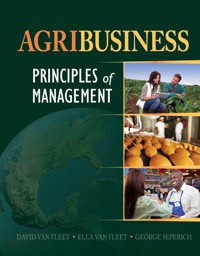The Roman author Quintilian provided the quote still used in the fashion industry today: vestis virdum redditclothes
Question:
The Roman author Quintilian provided the quote still used in the fashion industry today: vestis virdum reddit—clothes make the man. Mention Roman clothing and one item of apparel springs to mind—the toga.
The toga is as much an icon for the ancient Romans and their empire as it is today an occasion for a university fraternity party. The woolen toga worn over a linen tunic was a symbol of status and wealth. Interestingly, because it was not worn by Roman soldiers, the toga became a symbol for peace.
But time marches on, styles change, and the toga is no longer a part of everyday life. Similarly, the apparel and clothing industry is not often considered an important part of the agribusiness industry. Yet it is an important industry that developed with agriculture and the concomitant settling of communities. For the Romans, the shepherd guarding his flocks was as much a part of the countryside as wheat for bread and vineyards for wine. So it remains today. We have synthetic clothing materials, for example, nylon and other polyesters, and we also have natural materials. Synthetic material has its origin in petroleum derivatives;
natural material is derived from plants and animals. The agribusiness linkage is obvious.
The agribusiness orientation of the apparel and clothing industry means that it is under the same economic pressure as food—it is a basic necessity—and planning is critically important. Ask people to list their basic needs and they will mention three things automatically: food, clothing, and shelter. Food and clothing are rather similar. We have common, everyday foods and gourmet foods and we expect to pay a premium for the latter. So it is with clothing. We have common, everyday clothes and fashion-designer clothes with the attendant premium.
Clothing and food share another attention-getter: price. We do not buy clothing as often as we purchase food; however, it is a far more frequent purchase than many other items. A consequence of this purchasing pattern is a constant awareness of price. However, unlike food, clothing production for many countries is an easier export item than food. This is especially true of emerging countries seeking their places in global trade. And like many foods, the price of cotton and wool are often set in large commodity exchanges located in Chicago, New York, and London (and to some extent a few lesser exchanges). Thus, the price of these materials is generally the same all over the globe.
So the distinguishing competitive characteristic of clothing production centers on the cost of production and its consequent consumer price. Textile and clothing production is very labor intensive and therefore favors countries with inexpensive labor. Because of this, China has used its large population to capture a significant share of world clothing production. This competitive advantage led to the establishment of ten million small businesses that accounted for 60 percent of China’s economy and 80 percent of its jobs.
However, the success of this industry has led to pressure to increase wages to retain productive employees. Increased wages contributed to increased labor costs. This is a two-edged sword. It allows the employees to participate more actively in the Chinese economy as consumers; however, it also means that China’s competitive advantage is now only a comparative advantage and it is shrinking.
Rising labor costs in China are forcing U.S. apparel and accessories retailers, such as Ann Taylor Stores Corp. and Coach Inc., to develop plans that consider relocating at least some of their production to countries with cheaper workforces. Suddenly Pakistan, Bangladesh, and Vietnam are becoming competitive. For example, the average monthly wage of a textile worker in China is $412.50. A similarly employed worker in Thailand earns $245.50; a Filipino, $169.80 per month; a Vietnamese worker, $136 per month; and in Indonesia her counterpart makes $128.90 each month.
QUESTIONS
1. What planning tools or techniques are important in dealing with global competitiveness?
2. Discuss some of the reasons clothing manufacturers shift production from one country to another.
3. If you were a consultant to a clothing manufacturer, what sort of computer information database would you recommend for scanning the global environment?
Step by Step Answer:

Agribusiness Principles Of Management
ISBN: 9781285952352,9781285947839
1st Edition
Authors: David Van Fleet, Ella Van Fleet, George J. Seperich





